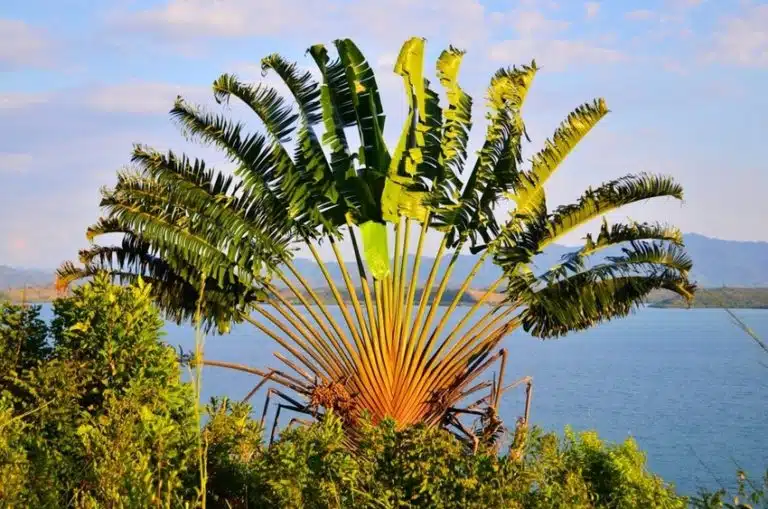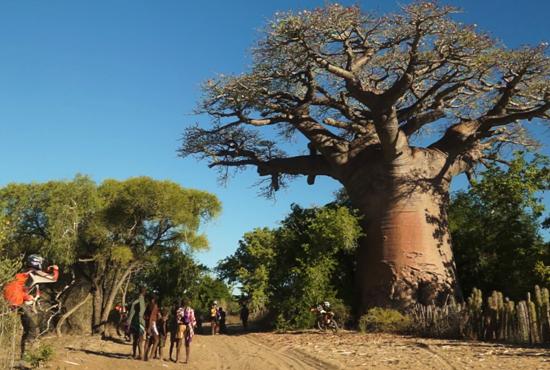Ravenala madagascariensis – Traveler’s Tree
Uniting Humans and Nature, a Symbol of Madagascar
The emblem of Madagascar is a tropical plant from the Strelitziaceae family, native to Madagascar. An endemic species, it is also the only species of its genus on the island and elsewhere, as Ravenala is a monospecific genus.
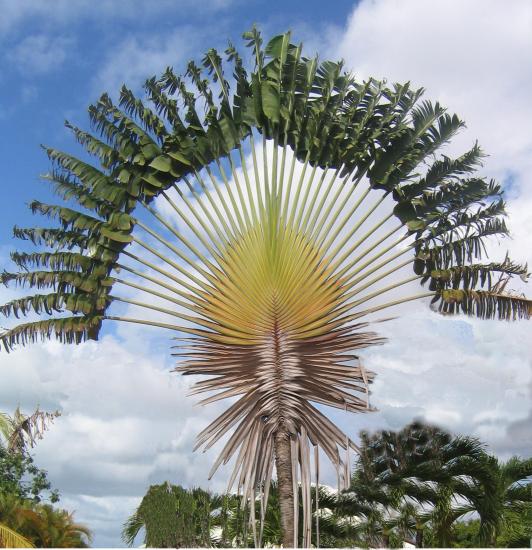
Its juice, abundant in the stems of the leaves, is drinkable and easily extractable with a machete. This fact has given it a reputation as a survival resource in case of emergency.
In western languages, the tree has earned its popular name because it helps quench the thirst of travelers.
In the east of Madagascar, 4 forms of Ravenala madagascariensis have been observed on slopes ranging from sea level to an altitude of 1000 m.
The first form, locally known as “Malama”, is rather rare and grows in the undergrowth of undisturbed submontane rainforests.
The juvenile phase is characterized by a secondary spiral arrangement of leaves, a long-stemmed leaf blade, the absence of leaf stalks, and a torus-like leaf arrangement; the mature phase has a fan-shaped crown.
The second form, “Hiranirana”, is more common in forest clearings and decaying primary forests, The juvenile phase of the plant resembles the typical fan-shaped form with well-developed petioles and a relatively wide leaf blade, as well as a slightly and regularly alternating leaf arrangement that persists in the adult phase.
The third form, ‘bemavo’, is the most common form that grows on deforested slopes between 300-600 meters above sea level and forms Ravenala forests; all phases have a fan-shaped crown.
The fourth form, ‘Horonorona’, grows on deforested plains, both on poorly and well-drained land, and differs from the other three forms in that it remains fairly small and develops numerous offshoots.
Description
Originally from The Traveler’s Palm, originating from Madagascar, belongs to the Strelitziaceae family.
It is not a tree (in the botanical sense of the word), but a perennial plant with a hollow stem, giving it a palm-like appearance.
Due to its shape and size, it is visible from afar.
The trunk can exceed a height of 10 meters, with a total height of about 20 meters.
The botanist Philibert Commerson discovered it during his stay in Madagascar in the years 1779-1780.
The huge leaves are fan-shaped and arranged in the same plane, with the tree often facing north/south.
Its fan-shaped leaves are a distinctive feature of this unique plant. Leaves hold rainwater, where many mosquitoes lay their eggs. In Madagascar, these water reservoirs host some very unique species that depend on this microhabitat (Amphibians, Beetles, and Mosquitoes).
The water collected at the end of the stems is not drinkable, it contains dead Insects, Frogs, some of which can only reproduce there.
When it blooms, it produces large white flowers with 3 sepals, 3 petals. In Madagascar, flowering begins in September and pollination is ensured by birds, bats, and lemurs.
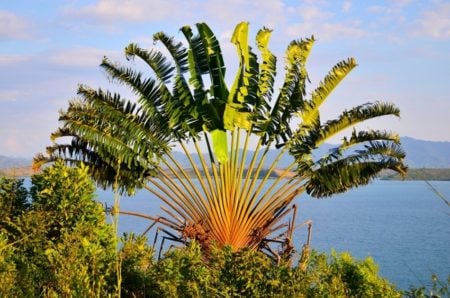
It will then go and deposit the precious seed on the pistil of another tree, willingly contributing to the reproduction of the Ravenala. The flowers usually open at night, with abundant nectar production reaching its maximum around midnight.
In Madagascar, the tree is mainly pollinated by several. Lemur species are pollinated, for example by the black-and-white ruffed lemur (Varecia variegata) and the black lemur (Eulemur macaco).
Lemurs appear to be highly dependent on the nectar of the Traveler’s Palm at certain times of the year.
In areas outside its natural range, the flowers are often visited by large bats such as Pteropus alecto gouldii and Macroglossus lagochilus.
Fruits are 6-lobed capsules resembling woody bananas, containing many seeds surrounded by intensely blue fibers that attract birds.
Ecology
An endemic species of Madagascar, the Traveler’s Palm tree predominates on the eastern side of the large island.
It is one of the. Rare endemic forest species that survive in secondary grass formations and exotic thickets always thrive on cool and moist soils.
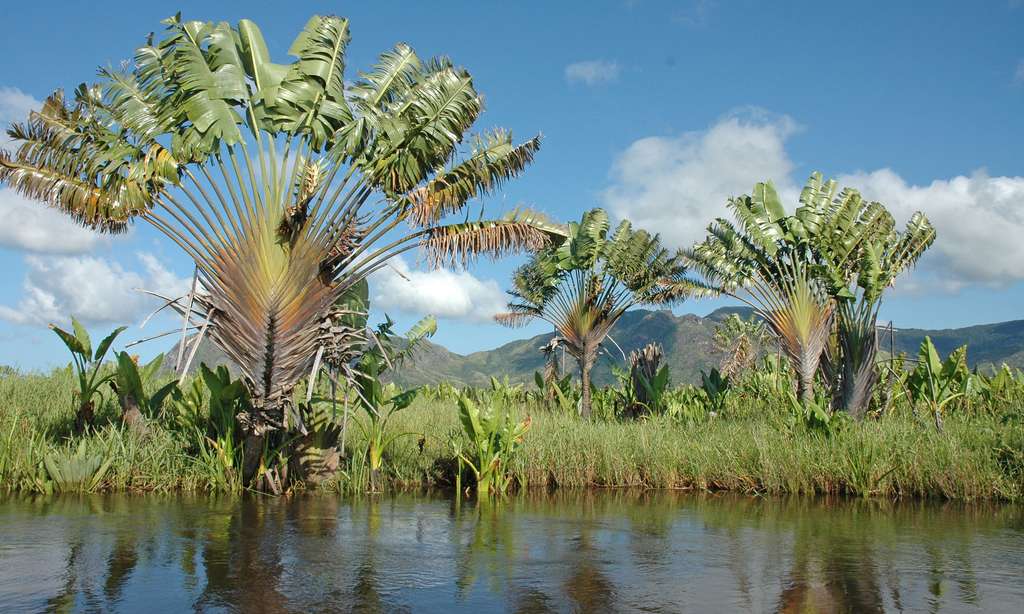
The Traveler’s palm tree prefers protected, warm, humid and humid areas near the coast between sea level and altitudes of 450 m, but can be found up to 1000 m above sea level.
The Traveler’s palm tree is also found on the island of Réunion, Mauritius, the Comoros (especially.
The Ravenala, also known as the Traveler’s Tree, is a plant native to Madagascar but can also be found in Mayotte, Guyana, Guadeloupe, Martinique, New Caledonia, French Polynesia, and in gardens of various tropical regions such as Thailand, Cameroon, Paraguay, where it has been introduced as an ornamental plant and sometimes becomes invasive.
Usage
On the east coast of Madagascar, its various parts are used as material for building traditional and functional plant huts. The split leaf stalks, known as Falafa, are used to make wall panels.
The dried leaves are used for roofing, and finally, flexible boards called Rapaka are made from the trunk, which are used for flooring.
The oil content of the seeds and kernels is 4% and 68%, respectively. The oils are used for various purposes.
The Ravinala palm tree has a fatty acid composition between palm oil and cocoa butter (oleic acid 39% and palmitic acid 34-42%) and can be a secondary source of plant-based butter. Sugar can be extracted from the stem sap. The seeds are edible but starchy, and the kernels are tasteless. The oil from the seeds is sometimes used for cooking and is said to have antiseptic properties. The pith of the stem is sometimes used as animal feed and can also be eaten as a salad with young leaves. The Ravinala palm tree is the emblem of Madagascar. On the airplanes of the national airline Air Madagascar, a machete blow at the base of the stem produces a particularly liquid juice that tastes similar to water.
It is possible to recover over a liter per machete blow after the rainy season, when the tree is fully saturated with water.
Cultivation
This relatively frost-resistant species has long been introduced in tropical botanical gardens around the world, including the Pamplemousses Botanical Garden in Mauritius, the Eala Botanical Garden in the Democratic Republic. Kongo, the National Tropical Botanical Garden in Hawaii, and the South China Botanical Garden in Guangzhou.
In temperate climates, it is grown under glass or in conservatories.
As the Traveler’s Tree is a popular ornamental tree that is widely cultivated, developing breeding varieties in different locations could be a good commercial option.
With deforestation in Madagascar progressing at an alarming rate, protecting this tree from uncontrolled logging may soon become necessary.
Medical Properties of Ravenala
The real question is: does this tree also have medical properties?
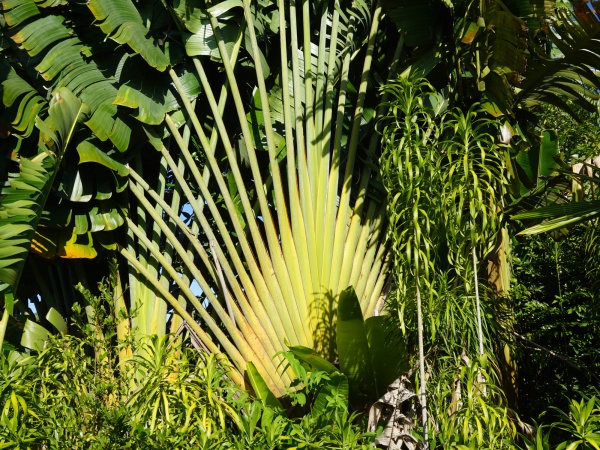
Es ist wichtig, die Vielseitigkeit und die potenziellen gesundheitlichen Vorteile von Pachypodium lamerei zu erkennen, auch wenn es nicht zu den bekanntesten Heilpflanzen gehört. Seine Verwendung bei Diabetes und Leberproblemen zeigt, dass es eine interessante Option für die traditionelle Medizin sein könnte.
Um mehr über die Verwendung von Pachypodium lamerei in der traditionellen Medizin zu erfahren, besuchen Sie bitte unsere Website unter www.traditionelleheilmittel.com/pachypodium-lamerei.
Many health benefits are attributed to the consumption of the fruit, including antioxidant properties and anti-inflammatory effects.
But it is the anti-diabetic activity that has caught the attention of scientists.
A study has shown the ability of the ethanolic extract (even more than the aqueous extract) to lower blood glucose levels.

